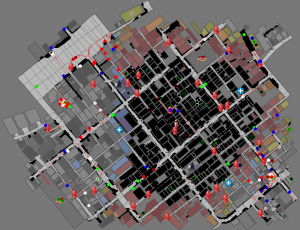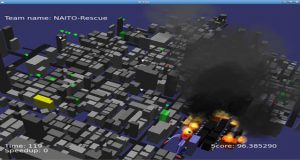The Agent Simulation competition involves primarily evaluating the performance of agent teams on different maps of the RoboCup Rescue Agent Simulation (RCRS) platform, a comprehensive simulation environment for research in disaster response management.. Specifically, this competition involves evaluating the effectiveness of Ambulances, Police Forces, and Fire Brigades agents on rescuing civilians and extinguishing fires in cities where an earthquake has just happened. This competition is composed of a preliminary round, a semi-final round, and a final round. Each round is composed of a set of maps representing different possible situations used for evaluating and scoring each agent team at each round. A consolidated score is assigned to each team per round.


During rescue operations after a disaster, cooperation is a must. In general the problem is not solvable by a single agent, and a heterogeneous team that dynamically combines individual capabilities in order to solve the task is needed. This requirement is due to the structural diversity of disaster areas, variety of evidence the sensors can perceive and to the necessity of quickly and reliably examining large regions. Yet, the performance of a joint rescue team depends on assembling the right mixture of capabilities and has to be designed as a whole.
Some disaster simulators and some agent simulators run in the disaster relief simulation. There are fire, collapse and blockage simulator as the disaster simulators. There are fire-brigade, ambulance-team, police-force and civilian agent (simulator) as the agent simulator. Participants develop the fire-brigade, ambulance-team and police-force agents’ strategies, which are algorithms. Other simulators are provided from RoboCup Rescue simulation project.
The committees of RoboCup Rescue simulation league prepare some scenarios for the competition. Competition consists preliminary, semi-final and final round. In every round, about 8 scenarios are given at the last minute of the competition. The scenario represents the following conditions of the disaster relief simulation.
- disaster area
- the number of each type of agents
- the location of the initial ignition points, building collapse, road blockages
- availability of communication among agents
In other words, participants need to develop algorithms which are suitable for every scenario.
Although the development of the agents is complicated, most of the codes are provided from the Agent Development Framework of RoboCup Rescue technical committees. So, participants can concentrate to develop own algorithms.
In competition, participants vie for mastery of the strategies of agents. The best performance team can get the highest score. The score is calculated from agents’ behaviors for each scenario. So, the winner is decided using sum of the scores.
Purpose
The goal of this competition is to take this technological and scientific challenge and extend current rescue strategies with planning, learning, and information exchange capabilities needed to coordinate their efforts and to accomplish the rescue mission as a team. More specifically, the competition aims to
- reveal a structure of disaster relief problem;
- dissolve concealed problems from the disaster relief problem and solve such problems;
- develop and store some algorithms and program codes;
- contribute to the real world with our results.
History
The earliest purpose of RoboCup Rescue project is that we apply technologies of RoboCup Soccer to disaster relief and life-saving. This project, which includes real-robot and simulation leagues, has been started in 2001.
The agent competition is directly an extended variant from soccer simulation league, although the simulation league currently has two competitions, the agent and the virtual robot competition. So, it implies that agent competition’s target is cooperation, coordination and coalition problem of autonomous agents.
The disaster relief problem of the agent competition is much more complicated problem than soccer problem of soccer (2D) simulation league. But, it is easy to join to agent competition’s community, because we provide a convenient software framework, which we call the Agent Development Framework (ADF).
Because the ADF provides a well-structured software architecture, participants can concentrate on their own interested problem only, even if the disaster relief problem is a more complex problem.
Besides, participants can easily re-use other participants’ results (source codes) through the ADF. Because all participants uses the same framework. In other words, they can compared own approach with others, easily. This is a good advantage of this agent competition.
Advantages
The agent competition has two features.
- We can tackled a worthful challenge, that is the disaster relief problem.
- It is easy for us to develop and analyze own ideas using the ADF.
The former is an important problem for all mankind. And the latter is also important for participants, which are researchers. As mentioned above, the agent competition has adopted the ADF. The ADF has the following advantages:
- We can study only interested areas.
- We can use the past research outcomes.
- We can analyze experiment results, effectively.
Item 1. is realized using the highly modularized ADF. The ADF has five algorithm modules, which are a dynamic resource-allocation, multi-agent path finding, information sharing, information collection and group formation problem. Through annual agent competition, we clarify the structure of the disaster relief problem, and then we can elaborate the problem progressively.
Item 2. is realized using opened resources, which are source codes. The agent competition community fully opened the source codes, which are used in annual competitions. So, we can re-use them easily to develop own idea or compare own idea with the pasts.
Item 3. is realized using a simulation execution management system, OACIS. The OACIS has been developed by Riken, Japanese National Laboratory. It can control all executions of experiments and gather all results, automatically.
